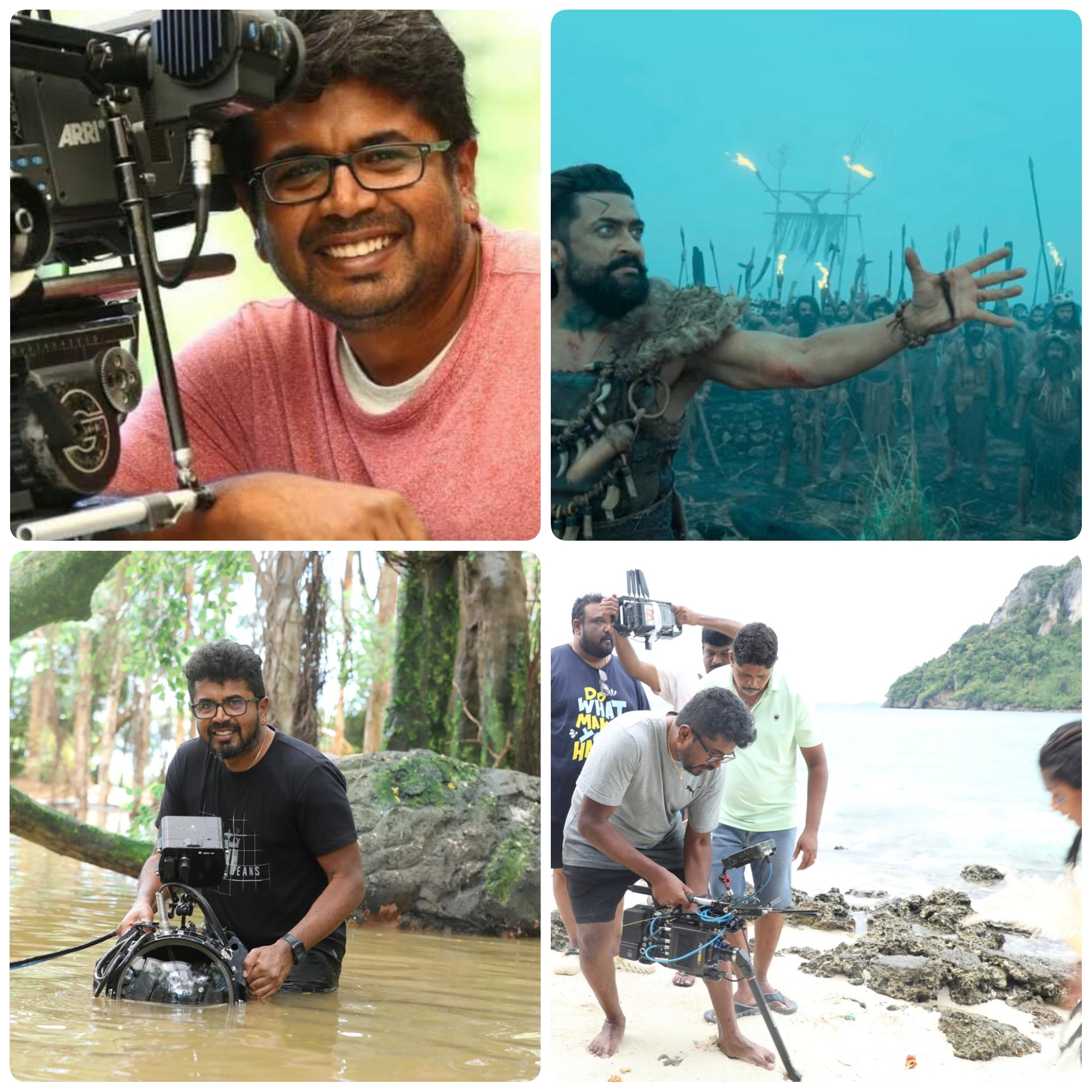
Vetri Palaniswamy DOP : Kanguva 3D!
Nov 29 2024
Vetri Palanisamy is a renowned Indian cinematographer celebrated for his visually stunning work in Tamil and Telugu cinema. An alumnus of the Film and Television Institute of Tamil Nadu, Chennai, Vetri has crafted memorable visuals in films like Souryam, Muni 2: Kanchana, Veeram, Vedalam, Viswasam, and Annaatthe.
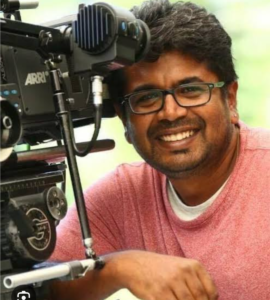
Known for his ability to bring unique atmospheres to life, his recent work in Kanguva has been widely acclaimed for groundbreaking 3D visuals, rich period settings, and innovative cinematography. Vetri’s dedication to his craft is evident in his meticulous approach, from researching global techniques to customizing equipment like the “Kanguva Smoke” machine for creating dense fog. His collaboration with directors, technical expertise, and creative vision continue to set benchmarks in Indian cinema.

He shares his extensive journey of making Kanguva with SICA
What was your first reaction after hearing the story of Kanguva?
I was excited because the story spans two eras, especially a period portion set 1000 years ago. This unique narrative inspired me and the director, Siva, to explore shooting the film in 3D to do justice to its scale.
How did you decide on 3D conversion rather than shooting directly in 3D?
A: After hearing about the complexities of shooting action sequences in 3D from Nirav Shah (who worked on 2.0), I researched 2D-to-3D conversion techniques. I was impressed by Vikrant Rona, which was shot in 2D and converted to 3D. Rays 3D Cochin, guided by Hariharasudhan, provided excellent test footage, convincing us to proceed with 2D shooting and later conversion.
What challenges did you face while preparing for the 3D experience?
To ensure optimal results, we composed frames with layered foreground, middle ground, and background while shooting. With 4500 shots in the film, including 3000 VFX-heavy scenes, we had extensive prep work for months to integrate both 3D and VFX seamlessly.

How did you approach creating the look for the period portion of the film?
This era was unique, depicting a tribal clan without palaces or metal ornaments. I wanted a dense, foggy, and island-like atmosphere, inspired by The Revenant. Creating this look outdoors was challenging, but we used customized fog machines and hung muslin cloth to block sunlight, sustaining the dense fog effect.
Can you elaborate on the lighting techniques used?
I avoided artificial light for daytime exteriors and even thermocol reflectors. For forest sequences, I used natural light with subtle sky leakage for separation and a dark, realistic tone. At night, I relied solely on fire sources, with the Arri Alexa 35 capturing stunning images at ISO 3200 without visible grain.
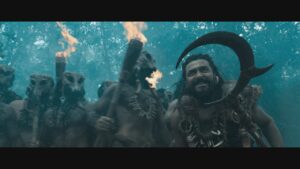
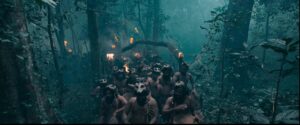
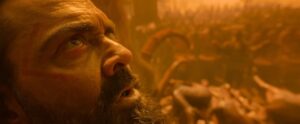
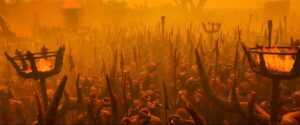
How did you differentiate between the hero’s clan and the villain’s clan visually?
Hero’s clan: Used a bluish-green tone with fog and mist for a serene and stunning look.
Villain’s clan: Shot with tobacco filters (1 and 2) and color-graded to a unique brownish-orange tone, emphasizing their brutal and bloody nature.
Which camera and lenses were used?
I shot with the Arri Alexa 35 and Arri Mini LF. For lenses, I primarily used Signature Primes, with the 18mm lens for about 90% of the shots. Gimbals, steadicams, and rope cams supported the long takes.
Few sequences i tried Probe lenses also which was very effective.
What challenges did you face in creating the foggy atmosphere in outdoor locations?
Creating a dense, consistent fog in an outdoor environment was one of the most difficult tasks. Regular fog machines in the industry could not sustain the level of density we needed for the visuals, especially in large, open areas like forests or hilltops.

How did you come up with the idea for a customized fog machine?
While shooting Vivegam, I had seen a foreign crew use a unique fog machine with a powerful blower and a long hose for even coverage. Remembering that experience, I decided to design a customized machine tailored to our specific needs for Kanguva.

What modifications were made to the fog machine?
1. Powerful Blower: We installed a high-capacity blower to ensure the fog could spread over large areas and maintain density
2. Hose Design: A long hose was created with minute holes throughout its length. This design allowed the fog to be distributed evenly in a 360-degree pattern.
3. Strong Fog Mix: We worked on creating a fog mix that would linger longer and blend naturally into the environment.
How was the fog distributed effectively over large areas?
The hose, with its small, evenly spaced holes, was key. It allowed the fog to escape uniformly, creating a natural, dense coverage. This ensured the fog appeared organic rather than artificial, which was crucial for achieving the film’s look.
How long did it take to develop and refine this customized fog machine?I
It took nearly two months of trial and error to finalize the design. We tested various configurations to ensure it could sustain dense fog for extended periods, even in challenging outdoor conditions.
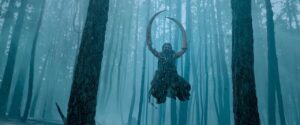
Were there any specific techniques used to integrate the fog with natural light?
Yes. To ensure the fog blended well with the environment, we avoided artificial light during daytime shoots. We also hung muslin cloth at the top of the trees to block direct sunlight, which helped sustain the fog and gave a diffused, moody look.
What were the results of using this customized fog machine?
The machine performed exceptionally well, creating the dense, misty atmosphere that was integral to the film’s period portions. The fog also acted as a natural fill light on the actors’ faces, enhancing the realistic lighting style.
How has the industry responded to this innovation?
After the release of Kanguva, the machine gained significant attention and was even nicknamed the “Kanguva Smoke.” Technicians and filmmakers have praised it for its ability to create a cinematic atmosphere on a large scale.
Do you think this innovation will be adopted in future films?
Absolutely. The success of the fog machine in Kanguva proves that customized solutions can elevate cinematic visuals. I believe this technique will inspire other filmmakers to innovate and experiment with similar approaches.
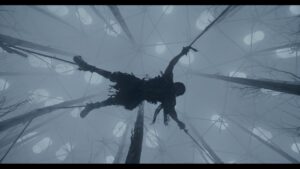
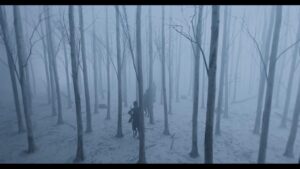
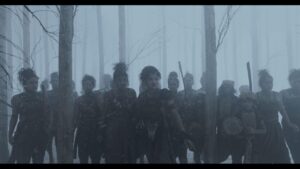

What were the standout sequences and techniques in the film?
1.Panikaadu Action Sequence (Post-Interval): Director Siva wanted to create a zero visibility type action sequence happening on a snowy atmosphere, creating a zero visibility even with our customized fog machine in outdoors is not possible so we created a indoor set at EVP with brilliant production design led by Art director Milan.
Shot in EVP Studios with 200 real eucalyptus trees. We used layered fog at both ground level and top level and 170 sky panels with lantern modifiers to create a unique zero-visibility daylight effect.
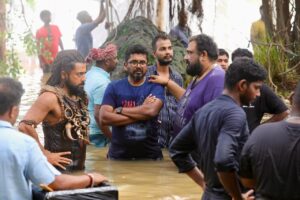

2. Crocodile Scene: Filmed in EVP Studios with a 6-foot water tank. Art director Milan created three crocodile models for realistic shots, enhanced with VFX. For the crocodile’s POV, I used fisheye lenses and underwater rigs.
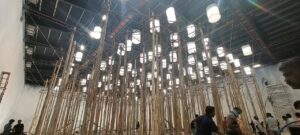
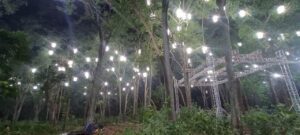
What made the climax sequence of Kanguva so unique and challenging?
The climax involved a massive action sequence set in a dense forest, requiring a sophisticated lighting setup, large-scale coordination of stunt performers, and a visually stunning atmosphere. Over 200 stuntmen participated in the sequence, and we had to ensure that the visuals matched the epic scale of the story while maintaining clarity and intensity.
How did you design the lighting setup for such a vast outdoor space?
To create a moonlit effect for the entire forest area, we used over 500 white halogen lights. These lights were connected to three DMX controllers for precise control. To diffuse the harshness of the lights, we attached lantern soft domes, which helped create a soft, natural glow that mimicked moonlight filtering through the trees.
–Were there any specific techniques to hide the lighting equipment?
Yes, we concealed the lighting rigs within the tree canopy to ensure they wouldn’t be visible in the frame. This also helped create a realistic source of light that appeared to emanate from the sky, enhancing the immersive feel of the scene.
How did you manage the large-scale coordination of 200 stuntmen?
Planning and rehearsals were critical. We divided the forest set into zones and choreographed the action sequences in a way that allowed the stuntmen to move seamlessly while interacting with the environment. Each zone had a lighting and camera team to ensure no part of the action was missed.
How did the dense forest environment add to the visual complexity of the scene?
A: The forest location in Rajahmundry was naturally dense, which added depth to the visuals. However, it also presented challenges in terms of movement, visibility, and maintaining a consistent look.
How did you achieve the seamless movement for long takes?
Long takes were a crucial part of the sequence. We used a combination of gimbals, steadicams, and rope cams to follow the action smoothly through the forest. This allowed us to capture the energy and intensity of the scene without breaking immersion.
Q: How did you ensure consistency in the moonlight effect across the entire area?
A: The DMX-controlled lighting setup allowed us to adjust the intensity and position of the halogen lights in real time. We also diffused the light through multiple layers of modifiers to create a consistent moonlight effect that felt natural and immersive across the large area.
What lessons did you take away from shooting the climax?
A: The experience reinforced the importance of detailed pre-production and the need to adapt creatively to on-set challenges. It also highlighted how innovative thinking and teamwork can push the boundaries of what’s possible in cinematic storytelling.
How did you manage the film’s color grading?
Colorist Raja Sekaran worked extensively during pre-production, providing multiple looks. The final grading was crucial in enhancing the film’s period and tribal aesthetics while maintaining a unique visual tone.
What equipment did you use to handle rain and water sequences in Kanguva?
For the rain and waterfall sequences, we used the Movmax Hurricane Rain Deflector. It’s a cutting-edge device designed to keep the lens clear in extreme wet conditions, ensuring uninterrupted filming with high visual clarity.
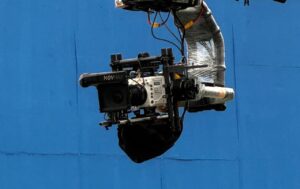
What makes the Movmax Hurricane Rain Deflector special?
It has several advanced features that made it ideal for the demanding conditions in Kanguva:
Stepless adjustment of internal and external circulation to prevent fogging.
Brushless motor operating at ultra-high speeds (up to 81,000 RPM), which creates a stable output of strong wind to keep the lens clean.
Straight waterfall wiper structure that prevents water from gathering in the center of the deflector, ensuring an even and clear view.
A double-layer rainproof glass with a hydrophobic coating, which prevents water droplets from clinging to the surface. The optical glass provides 99.7% transmission, delivering transparent and clean visuals.
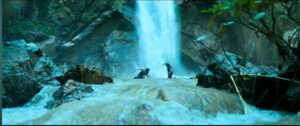
How long could the rain deflector operate continuously?
The device could work non-stop for up to 30 minutes, which was sufficient for capturing complex rain sequences without interruptions.
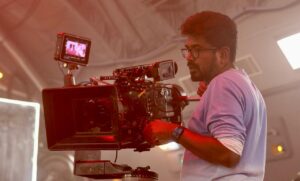
Was the deflector adaptable to extreme environments?
Absolutely. The Movmax Hurricane is IPX8 waterproof, which means it can withstand even the harshest water-based environments, including heavy rain and powerful waterfalls.
How did the rain deflector enhance the visual quality of the water sequences?
The combination of its high-speed rotation, double-sided hydrophobic coating, and transparent optical glass ensured that the visuals remained clear and sharp. There was no distortion or water build-up, allowing us to capture the splash and flow of water with remarkable detail.
Did this device contribute to the overall aesthetic of the film?
Definitely. By maintaining a clean lens even during intense water sequences, the rain deflector allowed us to focus on the intricate interplay of light, water, and motion. This played a significant role in creating the immersive and dramatic visuals that Kanguva is known for.
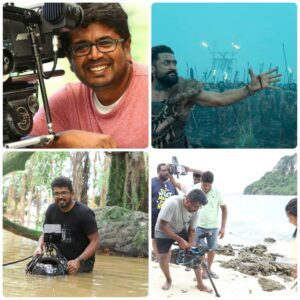
How has the film’s cinematography been received?
I’m thrilled that critics, technicians, and audiences have praised Kanguva’s visuals as one of the best 3D experiences in recent times. It’s particularly gratifying to hear that the customized fog machine we developed has been nicknamed the “Kanguva Smoke.”
Article by
CJ Rajkumar
Author/ Cinematigrapher
